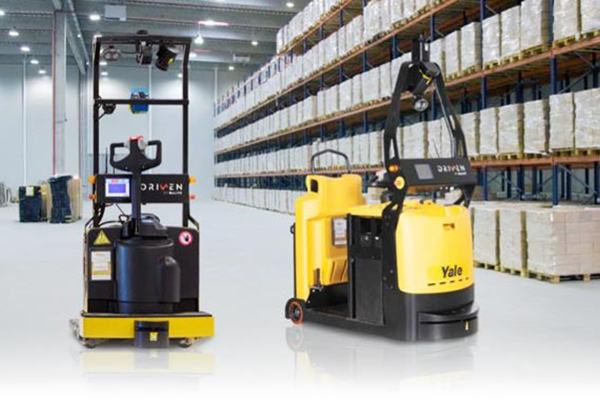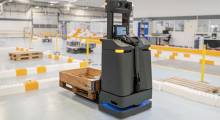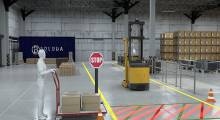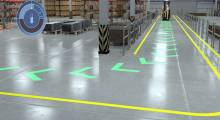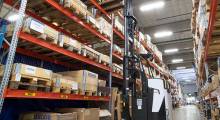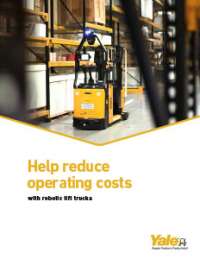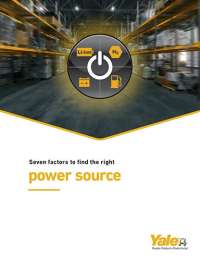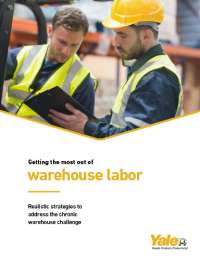While consumer demand fluctuates, the need for more efficient supply chains continues to grow, as does demand for automation. Yale Materials Handling works closely with customers to maximize the value of its automated lift trucks.
The global market for autonomous lift trucks could experience a compound annual growth rate (CAGR) 9.5% and expansion from $2 billion in 2021 to $4.65 billion by 2030, estimated Next Move Strategy Consulting.
Similarly, Markets and Markets forecast a CAGR of 12.7% from $3.1 billion in 2021 to $6.4 billion in 2027. Fortune Business Insights predicted an automated forklift CAGR of 8.3%, from $416.7 million in 2018 to $786.9 million by 2026.
Yale is part of Cleveland-based Hyster-Yale Materials Handling Inc., which designs, builds, sells, and services lift trucks. Modern Materials Handling, a sibling site to Robotics 24/7, listed the company as one of the top 20 lift truck suppliers for 2022.
Robotics 24/7 spoke with Kyle Smart, business development manager for robotics and automation at Yale Materials Handling, about how the company works with customers and is scaling to meet demand.
Yale supports vertical, horizontal applications
What autonomous products does Yale offer for materials handling?

Smart: We have a true vertical solution and multiple horizontal solutions. While we haven't expanded our portfolio, we are working with customers and partners to add automation.
Our focus is on continuing to provide offerings that best suit customers and their applications.
What are some examples of applications suitable for automation? Where should companies start?
Smart: From a vertical standpoint, the majority of time is spent on putaway to storage from inbound receipt, retrieval from storage to the outbound dock, and letdown or replenishment from storage to active locations.
There are also dedicated pick tunnels that are zoned or isolated, custom pallet-load areas, and even automated storage and retrieval systems [ASRS]. A lot of these are in general proximity to storage, which is more of a focal point in vertical applications.
From a horizontal perspective, one of the best low-hanging fruit for AMRs [autonomous mobile robots] is tugging with a tow tractor, moving multiple loads at a time and significiant payloads as well. It helps operators get used to pulling different configurations of trailers and products for long or short distances.
For example, the tuggers can move materials from kitting to the production line or take out the trash. Basic “milk runs” are great starter applications.
Every time someone has to move abstract loads—dimensionally or weight-wise— it's challenging but a great opportunity. Overall, point-to-point moves like crossdocking or from buffer zone to buffer zone can demonstrate uses for automated trucks.
Software and full automation
How does Yale address orchestration of vehicles and fleet management?
Smart: That aspect of robotics deployment is all-inclusive for our customers. We provide fleet management/host software with all our lift trucks. We set that up and install it for customer use, interfacing with WMS [warehouse management systems] and ERP [enterprise resource planning] systems.
We champion the use of our software even without that. We can provide the ability to move pieces of work even without a full-on interface.
You mentioned automated vertical storage. Is it desirable to keep humans “in the loop?”
Smart: When you’re talking about vertical robotics applications, we’re seeing and coaching customers to be able to scope implementations that are 100% automated.
Our racking is in distribution centers and warehouses, where you would not want to have manned vertical lifts operating within the same pick-and-drop locations as automated lifts, from an efficiency and a safety standpoint. Any time you start to introduce a Z axis with pick and drop, you need to identify loads, overcome tolerances, and track SKUs [stock-keeping units], but workers couldn’t get out of a manned vehicle.
If a customer wants to intermingle manually placed and automated picking, it introduces another level of complexity, which can lead to a lack of efficiency, more congestion, and longer wait times.
Does more automation require more management?
Smart: If you have 100% automated picking and pallet-in and pallet-out operations, you do need to understand where and how that occurs. We have over 300 vehicles alone in North America, so we have a lot of experience in how that can work and why.
With all our partnerships, our approach and mindset is to set customers up for success.
Yale expects continued growth
With more than 70% of North American warehouses yet to add automation, how much are you seeing adoption of robots versus adding them?
Smart: About half of what we’re currently doing is customers expanding what they have. And the other half of our projects are new installs in variety of industries.
Leading the top three are third-party logistics providers [3PLs]. Without a doubt, there are significant interest and initiatives. Many 3PLs already have automated or are looking to do so.
Next is consumer packaged goods. We're not so much in the e-commerce space, but it's up there.
Automotive is the third. Supplying manufacturing is absolutely the primary case. We're even seen some distribution areas making adjustments to support [automated] functions of those operations. Then there is food and beverage.
How is Yale handling growing sales? The company reported a 17% consolidated revenue increase in the second quarter of 2022 compared with Q2 2021, thanks to a 32.2% increase in lift truck shipments.
Smart: Everyone saw a pause in 2020, when COVID-19 took the world by surprise, but we've experienced growth in 2021 and 2022. We're really focused on scaling the organization.
It centers around self-reliance. The robotics and automation industry is made up of folks who have mastered a core technology that can be offered from a product standpoint, and then it's OEMs and partnerships.
For us, being self-reliant means building out our sales and business development organization to support all of our accounts across North America. This includes project management and aftermarket parts. We have teams under each of these that are continuing to grow and own the entire experience for the customer, so it doesn't have to deal with a multitude of entities.
A lot of customers are looking to learn about robotics and they want consistency and core technologies all under one roof.
Are you also working with systems integrators?
Smart: We do. A number of our dealers in North America have integrator entities within their business.
Yale robotics has been an integral part of more holistic solutions or installs. As with any technology, a lot of customers are looking for advances and are continuing to push the envelope. At the same time, they want products that are proven to be reliable.
The robotics industry hasn't reached maturity yet, so having a product that does what [vendors] say it can do and, most importantly, having a team that knows how to set up project scopes and provide long-run service—that's a key aspect of what we do.
Local service and support expertise allows us to keep lift trucks operating at all times. We're proud of that, especially with 100% automation.
Bill Gates said, “We always overestimate the change that will occur in the next two years and underestimate the change that will occur in the next 10.” That's absolutely my experience. Bringing automation to supply chains is a marathon, not a sprint.
About the Author
Follow Robotics 24/7 on Linkedin
Article topics
Email Sign Up

